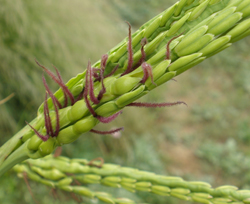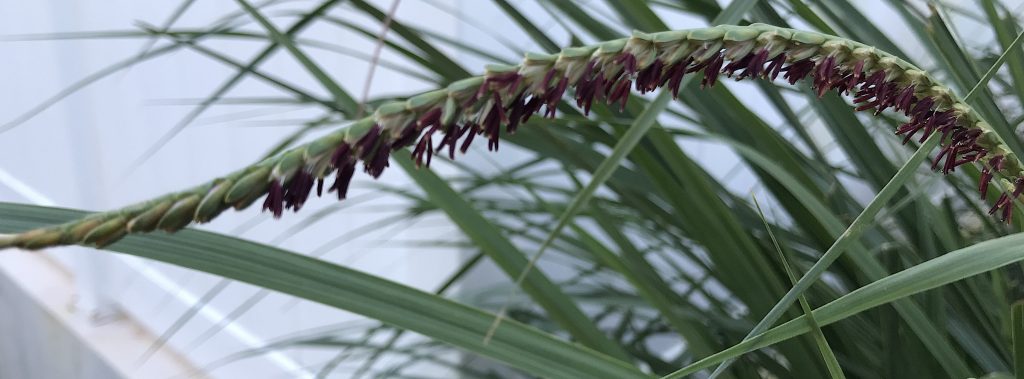
Eastern Gamagrass or Fakahatchee grass starting to blossom. Photo by Green Deane
Eastern Gamagrass, aka Fakahatchee Grass, is an edible you don’t see and then you do. This is because while a native it is used ornamentally and kept trimmed. So often you don’t notice it until it blossoms and seeds.
There are no toxic native North American grasses which helps to make Eastern Gamagrass one of my favorites. It was also top of the line for buffalo and cattle ranchers. While it does grow in clumps, it can be used like wheat and the seeds can even be popped like corn. The showy male flowers are on top of the stalk and the less extroverted female flowers further down. Wind and gravity aid in pollination. As mentioned it is often overlooked because for much of the year it can be an ornamentally trimmed clump that looks grassy, green and nondescript. But once you see the grass blossoming you will remember it. By the way “gama” means “range” so Eastern gamagrass is Eastern Range Grass. Fakahatchee is Seminole for “forked river” with the Hatchee part being the base word for creek, river or stream. To read about Eastern Gamagrass go here.
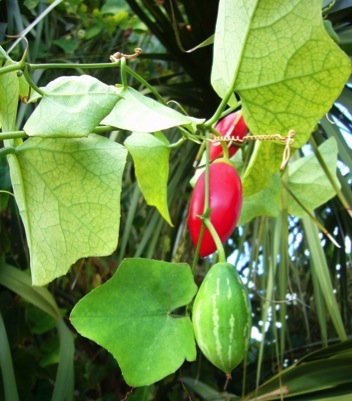
Ivy Gourd fruit ripens to red. Photo by Green Deane
Ivy Gourd leaves and fruit are edible raw or cooked. When unripe the fruit is used like a crunchy cucumber. When ripe it turns bright red and is high in beta carotene. It can be used in sauces and the like or to make candy. The leaves were used recently in an experiment to reduce glucose absorption and worked well. It only took 20 grams of raw leaves to do that. And the root has been used to make an herbal medicine for diabetics (probably those with type II diabetes.) There are many articles about the fruit and leaves. But what about the roots?
One of my readers wrote: “We eat the root after boiling. It has a distinct potato flavour, and if you get a good one … they are quite starchy and not fibrous… I cannot remember where I heard the roots were edible! I’m sure I did as I’m quite careful about these things. I slice them up across the diameter like a carrot and boil them as long as a potato. I sometimes peel them and sometimes don’t. To me they have a distinctive potato-like flavor. The skinnier ones tend to be a bit stringy, the fatter ones not stringy, and firmer than a potato. I like the texture. After boiling I have sometimes mixed them with other vegetables and stir fried them. They’ve never made me sick and I have a very sensitive stomach. Mind you I rarely have enough to make a whole meal of them, preferring to mix one or two of them with other vegetables.”
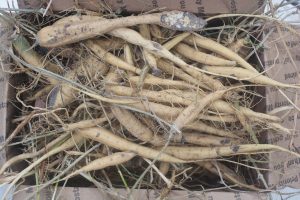
Ivy Gourd Roots. Photo by Green Deane
Interesting. One large caution, but also a possible positive, is that extracts of this plant including root definitely reduce blood glucose levels and in the lab also dramatically reduce lipid levels as well (cholesterol, triglycerides, and LDL while raising HDLs.) It might be a medicine of the future or perhaps a vegetable prescribed for wellness. This will not sit well with various official and unofficial groups that view the plant as an invasive species. Time and need might get it reclassified from “noxious” to beneficial. To read more about the Ivy Gourd go here.

Foraging classes are held rain or shine, heat or cold.
Foraging classes this week are in north central Florida and the middle west coast, Cassadaga Saturday and New Port Richey Sunday.
Saturday, January 11th, Colby-Alderman Park: 1099 Massachusetts Street, Cassadaga. Fla. 32706. 9 a.m. to Noon. Meet at the restrooms.
Sunday, January 12th, John Chestnut County Park: 2200 East Lake Road, Palm Harbor, FL 34685. 9 a.m. to noon. Meet at the beginning of the Peggy Park Trail inside John Chestnut Park. That is on the extreme south end of the park.
Saturday, January 18th, Wickham Park, 2500 Parkway Drive, Melbourne, FL. 9 a.m. to noon. Meet at the Dog Park inside the park.
For more information, to sign up for a class, or to pre-pay go here.
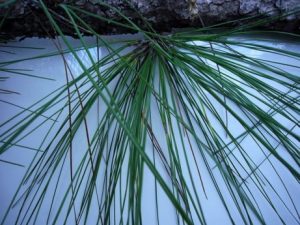
Pine Needle tea is good for the flu. Photo by Green Deane
What is a tea? It can be everything from a comforting drink to medicine. Indeed, some teas made from spices are very good for your health. Turmeric or rosemary tea come to mind. There are certainly dozens of wild plants that can be used for tea. In fact we even have a species and varieties locally that is full of caffeine and antioxidants, the Yaupon Holly. But teas can be more than teas. As I teach in my classes teas can often be marinades and the material that is used to make the tea can also be used for flavoring when cooking vegetables or meats. They will flavor a squash as easily as a fish. Besides caffeinated Yaupon Holly the non-caffeine Southern Wax Myrtle has been used a long time for tea though I think to be on the safe side it should be avoided by those who are pregnant. Local natives also smoked the leaves to keep insects at bay. Magnolia leaves have been used for tea and goldenrod, too. There’s one species of goldenrod that has a slight anise flavor and is the best of them all. An old stand by, of course, are pine needles for tea. Choose green needles and seep them (not boil, that drives off the Vitamin C.) They also have shikimic acid which is the main (refined) ingredient in Tamiflu. Camphor seedlings also have shikimic acid as does Sweet Gum Bark and Sassafras. There’s tea, marinades and medicine around us if we know how and where to look.
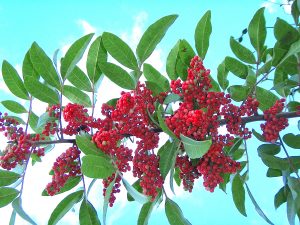
Brazilian Pepper grows out of the axil. Photo by Green Deane.
Botany Builder #10: Axil is a word you’ll read often in plant descriptions. It is the upper point where a leaf petiole (Botany Builder #2) meets the stem or where a branch meets the stem. They should have called it a juncture rather than an axil. We wouldn’t be too interested in that rather unremarkable location except plants often sprout branches, blossoms and fruit from that spot. In the Brazilian Pepper, right, the fruit is on the small green stem goes back to where a larger stem and a leaf meet. Where the larger stem and the leaf meet is the axil. Another member of this family grows toxic white berries out of the axil. A third member, however, does not. It grows berries at the very end of a branch rather than at the axil. When the berries are in a bunch at the end of a branch it is called a terminal cluster. Thus berries growing out of an axil are in a far different location than a terminal cluster. Brazilian Pepper berries have been used as spice. I have a video on them here.
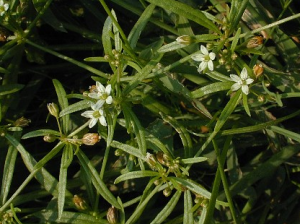
Carpetweed is an overlook straggler.
Through hot and cold weather, wet and dry, one weed found in nearly all of the Americas is the low-growing Carpetweed. It’s native to the Tropical Americas but that has not stopped it from spreading far and wide. I know for certain that the cooked leaves are edible, a few raw ones can go in salads. Mollugo comes from the Latin Mollis for soft. Verticillata means arranged in whorls. The plant’s life cycle is synchronized with showers particularly in dry areas. It can germinate, grow and go to seed within a month. More rain gives it more time. The main problem is it’s scraggly and is an addition rather than the main ingredient. Carpetweed does not compete well with taller plants (thus it loves bald patches in lawns.) Medicinally it can increase one’s nitric oxide production which lowers blood pressure. To read more about Carpetweed go here.
 Donations to upgrade EatTheWeeds.com have gone well. Thank you to all who have contributed to either via the Go Fund Me link, the PayPal donation link or by writing to Green Deane POB 941793 Maitland FL, 32794. There are many needs left such as expanding the foraging teacher page, the page on monotypic edibles and the Plant Archive page. There’s always something and such things get more complex and expensive every year.
Donations to upgrade EatTheWeeds.com have gone well. Thank you to all who have contributed to either via the Go Fund Me link, the PayPal donation link or by writing to Green Deane POB 941793 Maitland FL, 32794. There are many needs left such as expanding the foraging teacher page, the page on monotypic edibles and the Plant Archive page. There’s always something and such things get more complex and expensive every year.

The nine DVD set includes 135 videos.
Though your foraging may drop off during the winter it’s a great time to study wild edibles with my nine DVD set. Each DVDs has 15 videos for 135 in all. They make a great gift. Order today. Some of these videos are of better quality than my free ones on the Internet. They are the same videos but many people like to have their own copy. I burn and compile the sets myself so if you have any issues I handle them personally. There are no middle foragers. And I’m working on adding a tenth DVD. To learn more about the DVDs or to order them click here.
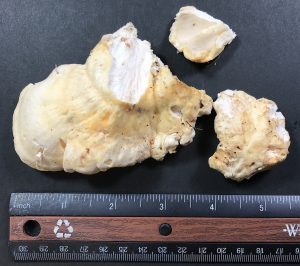
This is a choice wild mushroon which you would know if you read the Green Deane Forum.
Want to identify a plant? Perhaps you’re looking for a foraging reference? You might have a UFO, an Unidentified Flowering Object, you want identified. On the Green Deane Forum we — including Green Deane and others from around the world — chat about foraging all year. And it’s not just about warm-weather plants or just North American flora. Many nations share common weeds so there’s a lot to talk about, such as the one to the left. There’s also more than weeds. The reference section has information for foraging around the world. There are also articles on food preservation, and forgotten skills from making bows to fermenting food. Recent topics include: Asystasia gangetica aka Chinese Violet or Ganges Primrose, Armillaria mellea Ringed Honeys, Acorn Treatment Question, Acorn Questions Any Poisons? A Cure For The Common Cold, Lactifluus piperatus, Elderberry Capers? You can join the forum by clicking on the button on the upper right hand side of this page.
This is weekly newsletter 387, If you want to subscribe to this free newsletter you can find the sign-up form in the menu at the top of the page.
To donate to the Green Deane Newsletter click here.

